Posted on May 17, 2020
Alien Science Post-mortem
Adventure Jam 2020
You can find the details here.
And my entry Alien Science here.
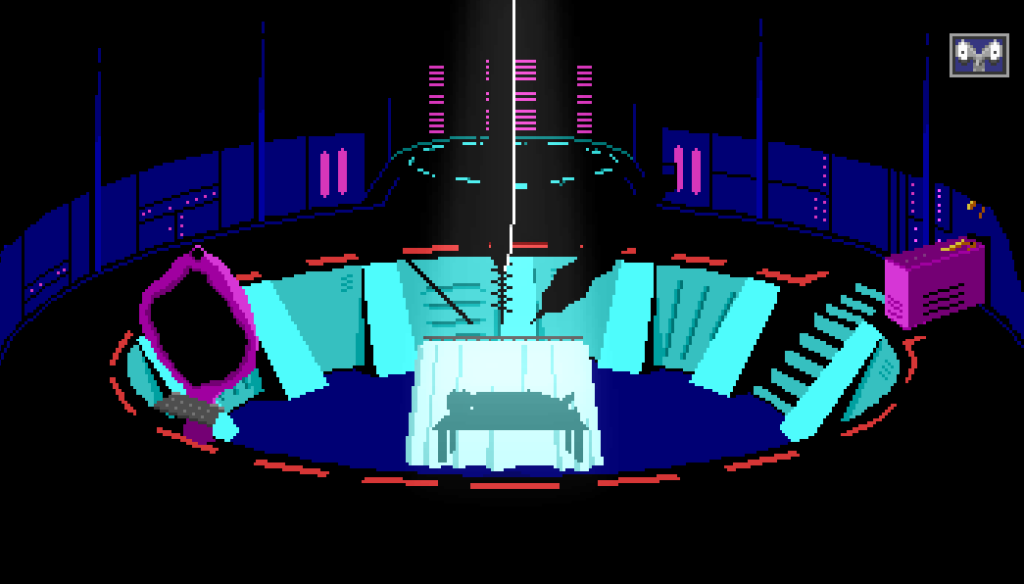
Initial idea
The initial idea I had was this:
You live alone in a little cave high up a cliff, in a very foggy rainy climate. You’ve never seen anyone else, and you assume this is all there is. You go about your daily tasks (eating, collecting water, defending the nest from bad animals). One day, the rain stops. The next day, the clouds clear.
You spot someone just like you on a cliff on the other side of a chasm. They are also going about their daily tasks. The gameplay would involve learning how to communicate with them, helping them, and getting them to help you (you string a lightweight line across the chasm to ferry supplies). It would finally result in you being able to cross to the other side. They run into their cave. You follow them. You end up inside your cave. Was it just you all along?

It seemed a bit somber, and I couldn’t figure out how to implement the puzzles (especially learning how to communicate with them).
Then late at night on day 1, I completely rewrote the story to be one of alien abduction. I needed something lighthearted. And I had come up with something I was pretty happy with, which included a couple of surprise moments. So time to actually start on the jam…
Alien language
On the 2nd day, not yet having finalized all the puzzles, I decided to put that off and work on some garbled alien language simulation. I recorded myself making a bunch of weird noises. Then I isolated them all in my video editor, and exported them as separate audio files for import in Unity.
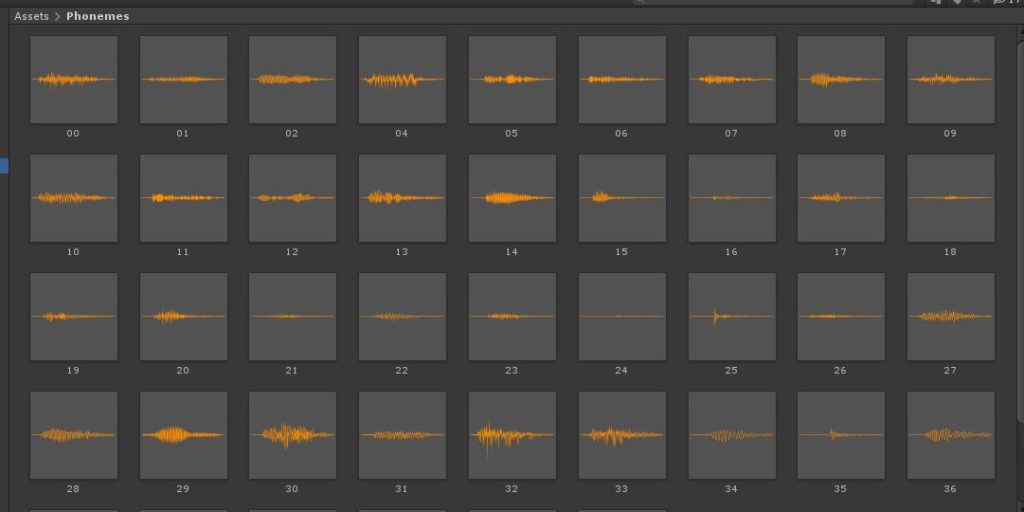
Then at runtime, when presented with a string, I break it into words, and then 3 letter chunks. I calculate a hash from these small chunks and use it to index into an array to choose a phoneme. I roughly classified half the phonemes into consonants and the other half into vowels, and then I alternate between them. Each phoneme is blended into the adjacent ones based on where it starts “being loud”. The result… kind of sounds like predictable alien speech.
I also tried to insert pauses to correspond to punctuation in the input text, but couldn’t get it quite right. The same goes for my attempt to shift the pitch throughout a sentence. At this point I’d already wasted enough time on something that wasn’t super essential, so I called it good enough.
Abduction room
This is the first scene in the game where you can control the character. This took way too long to implement. Part of it was just re-familiarizing myself with my adventure game framework after having not used it for so long. But I think I spent nearly 3 days coding up all the stuff in this room. (This worried me, but luckily the other rooms ended up being much simpler).
The challenges were:
- 3 separate movable abduction tools on a separately movable main arm
- a screen that showed a magnified view of which orifice you are abducting
- some sort of console/UI that supports keyboard and mouse control of said abduction tools
- smooth transitions in and out of using the console
- 2 separate but overlapping pathfinding zones, which you can sometimes walk between but not always
- a relatively long cutscene
- 3 aliens providing live commentary on your work
- a bunch of timed hints, since this is the opening of the game and I don’t want the player to get blocked
- the ability to go from a standing movable player character to one lying still on a bed
- some slightly complicated stencil effects (I had to re-familiarize myself with how I’d implemented that functionality in my framework)
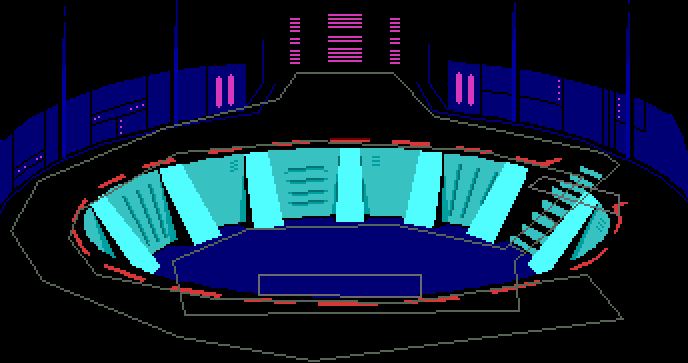
The abduction room has multiple overlapping pathfinding zones, depending on if you’re in the pit or on the walkway above.
I struggled with how to show the abduction tools. I originally wanted large complicated scary-looking things, but I didn’t really have time to draw them properly. So in the end I decided to just make them silhouettes – this saved time and actually helped with the atmosphere a bit?
Rotoscoping
This was (I think?) my first attempt at rotoscoping. I wanted to do that for both the alien and human sprites, but I waited until near the end of the jam to do the human, and there just wasn’t enough time. So I ended up re-purposing and modifying an old sprite.
For the alien, I first sketched out some ideas on paper.
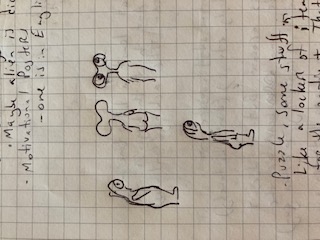
Alien with ample buttocks
The entire rotoscoping process took about 4 hours. It was pretty tedious, but it went ok for my first attempt. I’m sure there are a lot of workflow improvements for those with more experience.
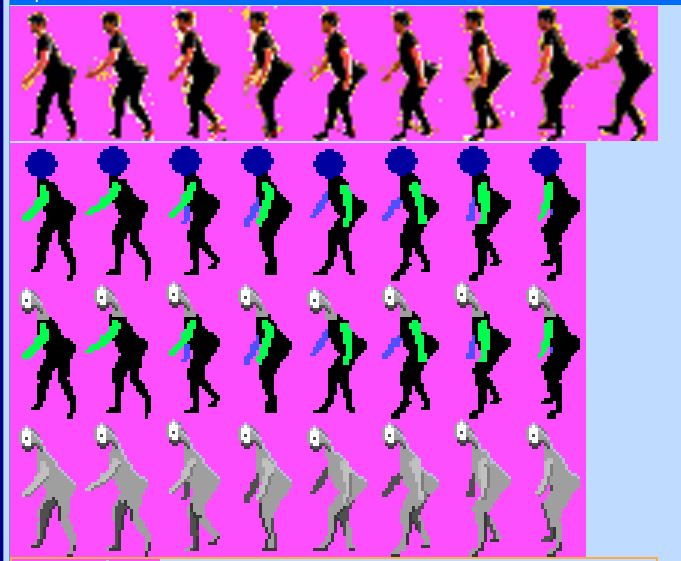
Various stages of cleaning up the original video frames
Ship layout
I spent a while figuring out different possible configurations. I had a lot of constraints, which helped. Specifically, I wanted to be able to use the same sprite for all doors, so I wouldn’t have to draw them a various angles. The captain’s quarters needed to be adjacent to the laboratory for story purposes. Maybe four or five days into the jam I settled on what ended up being the final (somewhat unusual) configuration (I did end up shuffling some rooms around). Figuring out a layout and a “philosophy” for the layout of the ship helped a lot with placing elevators, doors, etc…

What went well
I figured out most of the story and puzzles within a few hours on day 1. I was able to come up with a puzzle dependency chart that didn’t change all that much.
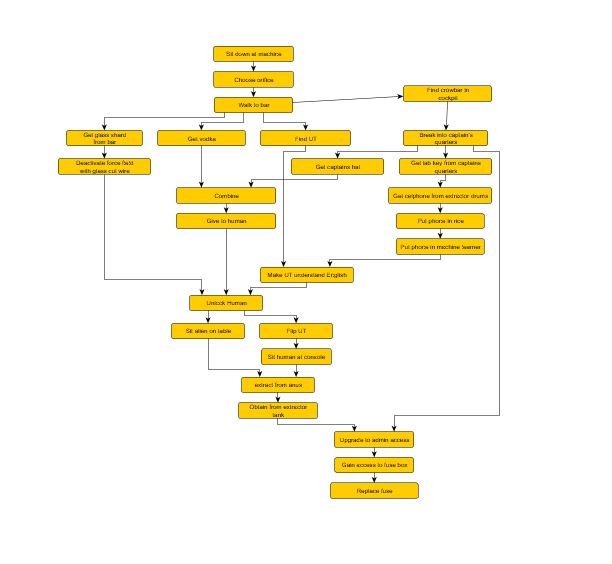
I guess this was useful, but I didn’t end up referencing it much during the remainder of the two weeks. I guess it’s a small enough set of puzzles that I could keep it in mind. I’m not sure exactly how useful I find PDC’s – They’re fine for ensuring you don’t have any dead ends or impossible situations, but I feel some kind of “knowledge dependency chart” would also be useful just for overall story flow.
I had a friend do music this time, instead of relying on royal-free music, and it worked out pretty well. He even did separate versions of the abduction music, which will make sense if you played the game.
I compiled nearly all the sound effects in a 4 hour span a day or two before the end of the jam. I started recording my own, but that was too tedious. So I just ended up purchasing most of them on soundsnap. Perhaps I should have asked in the jam’s sound design channel on discord, but it was a bit late for that.
Overall workflow
After spending much of the first week on four things: 1) a story that I ultimately rejected, 2) the abduction room, 3) alien speech 4) rotoscoping the alien sprite, I finished things off in the following order:
- I did very rough passes on all the rooms in the ship (there are six). Enough to make them just barely functional: doors/elevators in and out, pathfinding boundaries and rough shape. But now I could walk around the ship, and it finally felt like a bit of a game
- Then I implemented the majority of the puzzles. When there’s so much to do in so little time, I usually find it better to implement tons of stuff without really testing. Then I test all the new stuff in one pass.
- Then I started polishing up the art in the rooms, along with the art for the inventory items and other props.
I sent a build out to four friends about 12 hours before the deadline. Playtesting is actually pretty exhausting from a developer’s point of view – there’s so much data to sift through. It’s hard to concentrate on anything else when getting feedback, so it was good that all four playtests were done within a few hours. Then I had another nine hours or so of reacting to that feedback… fixing bugs and redoing some things. I also had to test that actually builds worked.
I ended up submitting a PC build about an hour before the deadline. Then I went to sleep, and made a WebGL build later in the day.

